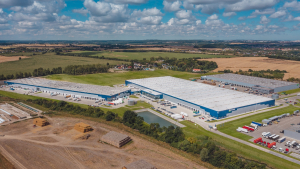
Sylvie Geuten-Carpentier, Managing Director Poland and Tomas Cifra, Managing Director Romania, Czech Republic & Slovakia at Mitiska REIM talked to Property Forum about the trends driving the convenience retail market and shared some insight into the company’s investment strategy.
Retail parks have emerged as one of the “winners” of the pandemic but their main advantage – access to stores from the open street / parking lot – is less relevant now as Europeans are learning to live with Covid. How do you see the long-term prospects of this asset type and its attractiveness as an investment product?
While it is certainly true that retail parks continued to perform strongly through the extraordinary circumstances of the pandemic, it’s important to note that the trends that existed in retail prior to COVID have become more pronounced and are now accelerating the divergence between winners and losers in the retail sector.
One trend is that consumers have become progressively time-poor but at the same time increasingly value-oriented. This has led to their selection of retail channels becoming based on either the experience that the shopping delivers or the convenience offered by different retail channels. When it comes to experience, destination-driven shopping at prime dominant high streets, shopping centres and outlet centres will continue to attract consumers’ discretionary spending in 2022 and beyond.
Convenience is at the other end of the spectrum and has been brought to the fore even further by the pandemic. As consumers have continued to become more purpose-driven and value-oriented in their shopping, they've been choosing retail parks and e-commerce for their essential spending.
As a result of this polarisation, it is the ‘squeezed middle’ of non-prime retail in city centres and small shopping centres lacking a unique proposition that has been most impacted during the pandemic and will continue to be so moving forward.
We expect the trend of polarisation to continue and the retail park offering based on convenience, essential shopping and value for money to remain a popular channel for shoppers, retailers and investors alike. At Mitiska REIM, we have seen the appetite by all stakeholders and investors grow, particularly since the end of last year, and expect this to continue, supported by the proven resilience of the asset class, its defensive rental levels and the attractive yield profile.

Sylvie Geuten-Carpentier
Managing Director Poland
Mitiska REIM
Has footfall and turnover returned to the pre-pandemic level in your retail assets in CEE?
Yes, the temporary restrictions on trading only had a short-term impact on footfall and turnover and the retail parks in our portfolio quickly recovered and are now performing better than they were pre-Covid.
One clear lesson from the pandemic is that not all retail is the same. Industry research findings have consistently shown that for key metrics such as vacancy rates, rents, yields, capital values and footfall, retail parks remain a resilient value proposition, having performed better than high streets and shopping centres both during and after lockdowns and have bounced back quicker.

Tomas Cifra
Managing Director Romania, Czech Republic & Slovakia
Mitiska REIM
Have you observed any significant changes in your tenant mix since the start of the pandemic?
While the pandemic has not really resulted in a significant change in our tenant mix within the retail parks in the portfolio, it has accelerated a wider change in tenant demand for what we call ‘convenience real estate’.
Retail parks were already evolving pre-pandemic and have come a long way from the individual ‘big box’ units on urban periphery locations of 10 years ago. Food anchoring has always been a key aspect of the retail park concept, which certainly came to the fore as a strength during the pandemic, and still remains an important driver of daily footfall today.
But today, the retail park concept has evolved beyond traditional retail and has moved into convenience real estate. Sited on urban infill locations, these convenience real estate projects now offer restaurants, leisure, fitness, medical practices and pharmacies, click and collect pick-up points, electric car charging stations, and many more consumer service needs. In addition, they also cater for mixed-use, with small business units, small offices, self-storage facilities, light industrial uses and urban logistics.
For the past several years we have seen an accelerating opportunity in convenience real estate driven by the converging trends in retail, urban logistics and multi-let light industrial, and the increasing demand for urban infill sites that offer accessible locations, affordable buildings and flexible design to a growing range of end-users.
Looking ahead, our view as a specialist investment manager is that we expect to see increasing recognition of retail parks and the broader opportunity in convenience real estate, which will create exciting new investment opportunities in this niche segment of the market.
At the moment, you’re present in four CEE countries – Poland, Slovakia, Czech Republic and Romania. Are you planning to enter other markets in the region?
We have no plans to enter additional CEE countries at this stage. Over the past 10 years, Mitiska REIM has built a geographically diverse portfolio of 91 properties representing +/- 1,100,000 sqm gross leasable area across Belgium, The Netherlands, France, Germany, Spain and Portugal, in addition to our CEE markets of Romania, Poland, Czech Republic and Slovakia.
Moving forward, our plans are to continue to diversify into convenience real estate, to capitalise on the opportunities we see from the converging trends in retail parks, urban logistics and multi-let light industrial and we’re currently developing projects of this type in our CEE markets.
In general, we are aiming to densify our market positions within our existing markets, where we have teams and local operating partners in place and continue to witness solid demand and potential for our convenience real estate strategy.
How has banks' approach towards financing convenience retail changed since the start of the pandemic?
It is true to say that Covid was the ultimate stress test for retail assets, with banks realising that not all retail is the same. Our experience is that bankers have noticed the strong resilience of the retail park sector but, as it was prior to the pandemic, factors such as reputation, investment strategy and track record remain key.
As an experienced and specialist player, we’ve continued to have access to debt capital through the pandemic and are seeing increasing interest from banks in the area of convenience real estate moving forward.
A growing opportunity we are also seeing is in the field of green loans which incorporate sustainability features into long-term bank financing. At present, a quarter of our debt portfolio is in the form of green loans and our aim is to establish a broader green financing framework in which to increase the number of green loans across the 10 European markets in which we operate.
Rising inflation and interest rate present a major challenge for most investors. How do you expect financing conditions to change over the next 12 months?
We don’t expect an adverse impact on the availability of debt financing as we have financing arrangements in place and benefit from strong relationships and a solid reputation with banks and financing providers. These arrangements include hedging against increasing short-term interest rates. For new transactions, the interest cost will increase due to higher short and mid-term interest rates. But our business plans do not rely heavily on debt financing as we tend to work with moderate leverage. Finally, convenience real estate segments are amongst the highest yielding segments still within the real estate market, continuing to provide sufficient margin between yields and interest rates.
Sustainability is playing an increasing role in retail too. What are the key elements of your ESG strategy?
The market’s perspective on sustainability has certainly now moved from a ‘nice to have’ to a key requirement, with green credentials now seen as a premium for commercial property. At Mitiska REIM, we believe that considerations concerning ESG factors play a crucial role in being a responsible fund advisor and are a key driver in creating long-term value for all our stakeholders and society by making our business and our managed assets ‘future-proof’.
2021 was a key strategic year for us in which we formalised our ESG strategy in an integrated framework by defining ambitions and targets built around three focus areas – our own operations, our investment process and our portfolio of investments – which provide a clear approach for both our current and future actions.
We have made significant progress in the adoption of metrics such as GRESB performance, BREEAM ratings and CRREM alignment, and the inclusion of initiatives such as solar panels, EV charging stations and LED lighting into designs and refurbishment plans.
Some key highlights in recent months include increasing the number of BREEAM (in use) certified assets to 45% in 2021 and we’re on track for a further increase to 85% in 2022. Plus, in October last year, we opened our flagship project “Malinas” in Mechelen (Belgium) which will receive an “Excellent” BREEAM in use rating and is Europe’s first CO2 neutral retail park.



